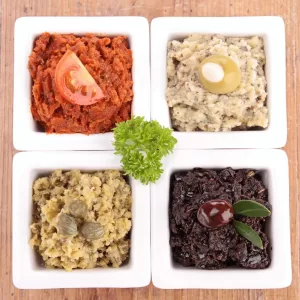Pâtés and Pastes: Versatile Delights of Global Gastronomy
Pâtés and pastes are multifaceted components of international cuisine
These concentrated, flavor-rich preparations are proof that simplicity and quality ingredients often speak louder when it comes to creating memorable dishes.
Let’s explore some of the most iconic pâtés and pastes and their culinary applications.
Liver Pâté (Foie Gras)
This is a classic of French cuisine. Liver pâté is a smooth emulsion of liver, usually chicken or duck, with butter, herbs, and sometimes a touch of brandy or other liqueur.
It is rich in iron and vitamin A, making it not only delicious, but also nutritious. Served with toast or rustic bread, it makes an excellent appetizer or component in a charcuterie plate.
Olive pâté
Known as tapenade in Provence, olive pâté is a thick paste made from black or green olives, capers, anchovies and olive oil.
Olives are rich in healthy fats and vitamin E. This pâté is perfect as a dip for bread, a stuffing for poultry or as a complement to enhance pasta dishes.
Hummus
Originally from the Middle East, hummus is a creamy paste made from chickpeas, tahini (sesame paste), lemon juice and garlic. It’s an excellent source of protein and fiber, promoting a balanced diet.
Hummus is extremely versatile – serve it as a dip with raw vegetables, spread it on sandwiches or use it as a base for salads.
Pesto
Pesto, a Genoese invention, is a paste made from fresh basil, pine nuts, garlic, parmesan or pecorino cheese and olive oil. It is a joker in the kitchen, serving well as a sauce for pasta, a marinade for seafood or a condiment for pizzas.
Pesto is rich in monounsaturated fatty acids and antioxidants, thanks to the olive oil and basil.
Chickpea pâté
Similar to hummus but usually with fewer ingredients, chickpea pâté focuses on the mild, earthy flavor of chickpeas.
This pâté can be enriched with fresh herbs or spices and serves as an excellent spread on snacks or to enhance cold cuts.
Salmon mousse
This delicate and light pâté is made from fresh or smoked salmon, mixed with cream, butter and sometimes a touch of dill or chives. It is rich in omega-3 and serves as a sophisticated appetizer on blinis or black bread toast, reflecting the elegance of French cuisine.

Baba Ganoush
This Middle Eastern dish is a smoked eggplant paste, incorporated with tahini, garlic, lemon juice and various herbs.
Rich in fiber and with a unique taste, baba ganoush is great as a dip, a complement to grilled vegetables or as a tasty spread on wraps.
Dried tomato pâté
With an intense, slightly sweet flavor, dried tomato pâté is a paste made from rehydrated dried tomatoes, olive oil, garlic and herbs.
It’s a great accompaniment to cheeses, can be used to enhance sandwiches or as a base for pasta sauces.
Rillettes
Originally from France, rillettes is a kind of rustic pâté made from pork, goose, duck or even fish, slow-cooked in fat until it can be easily shredded, and then mixed with its own fat to form a paste. It’s a rich and tasty option to spread on rustic bread or crackers.
Shrimp Pâté
A delicate pâté made with cooked and ground prawns, mixed with butter, cream and spices such as cognac, lemon juice and herbs.
This pâté is a luxurious addition to canapés and festivities.
Chestnut Pâté
A vegetarian and nutrient-rich option, this pâté is made from nuts such as cashews or Brazil nuts, processed with garlic, olive oil and herbs. It offers a rich, creamy texture and is a nutritious alternative to traditional pâtés.
Guacamole
This is a Mexican spread made from mashed ripe avocados, tomatoes, onion, coriander, lime juice and chili. As well as being delicious as a dip or in tacos and burritos, guacamole is full of healthy fats and antioxidants.
Getting to know these recipes gives us an insight into the creativity and rich cultural tapestry that world cuisine has to offer. Each pâté and paste carries with it the essence of its place of origin and invites you on a sensory journey that goes far beyond the palate.
Each of these pâtés and pastes brings with it a history, a culture and a nutritional richness that can enrich any meal plan.
I encourage lovers of good food to explore these delights, trying them in different culinary contexts and discovering their infinite possibilities.